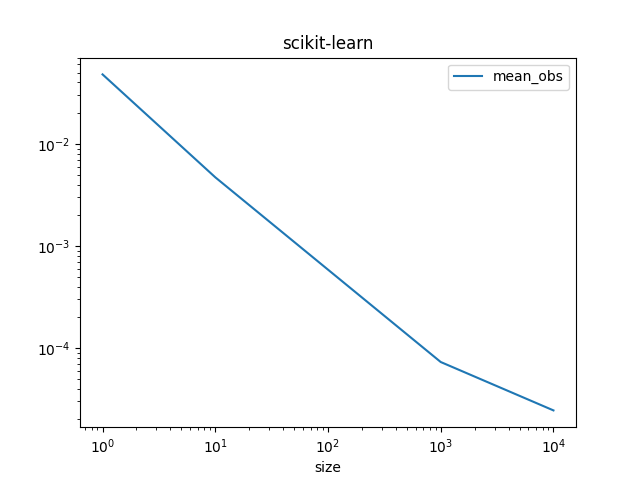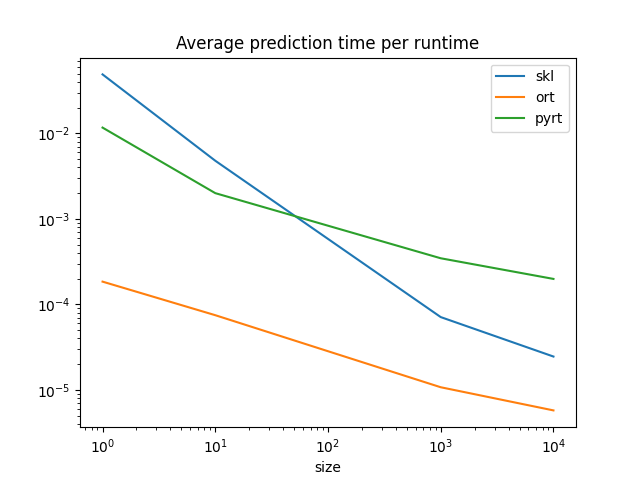Note
Go to the end to download the full example code
Benchmark ONNX conversion#
Example Train and deploy a scikit-learn pipeline converts a simple model. This example takes a similar example but on random data and compares the processing time required by each option to compute predictions.
Training a pipeline#
import numpy
from pandas import DataFrame
from tqdm import tqdm
from sklearn import config_context
from sklearn.datasets import make_regression
from sklearn.ensemble import (
GradientBoostingRegressor, RandomForestRegressor,
VotingRegressor)
from sklearn.linear_model import LinearRegression
from sklearn.model_selection import train_test_split
from mlprodict.onnxrt import OnnxInference
from onnxruntime import InferenceSession
from skl2onnx import to_onnx
from skl2onnx.tutorial import measure_time
N = 11000
X, y = make_regression(N, n_features=10)
X_train, X_test, y_train, y_test = train_test_split(
X, y, train_size=0.01)
print("Train shape", X_train.shape)
print("Test shape", X_test.shape)
reg1 = GradientBoostingRegressor(random_state=1)
reg2 = RandomForestRegressor(random_state=1)
reg3 = LinearRegression()
ereg = VotingRegressor([('gb', reg1), ('rf', reg2), ('lr', reg3)])
ereg.fit(X_train, y_train)
Train shape (110, 10)
Test shape (10890, 10)
Measure the processing time#
We use function skl2onnx.tutorial.measure_time().
The page about assume_finite
may be useful if you need to optimize the prediction.
We measure the processing time per observation whether
or not an observation belongs to a batch or is a single one.
sizes = [(1, 50), (10, 50), (1000, 10), (10000, 5)]
with config_context(assume_finite=True):
obs = []
for batch_size, repeat in tqdm(sizes):
context = {"ereg": ereg, 'X': X_test[:batch_size]}
mt = measure_time(
"ereg.predict(X)", context, div_by_number=True,
number=10, repeat=repeat)
mt['size'] = context['X'].shape[0]
mt['mean_obs'] = mt['average'] / mt['size']
obs.append(mt)
df_skl = DataFrame(obs)
df_skl
0%| | 0/4 [00:00<?, ?it/s]
25%|##5 | 1/4 [00:23<01:11, 23.98s/it]
50%|##### | 2/4 [00:47<00:47, 23.72s/it]
75%|#######5 | 3/4 [00:54<00:16, 16.22s/it]
100%|##########| 4/4 [01:07<00:00, 14.66s/it]
100%|##########| 4/4 [01:07<00:00, 16.77s/it]
Graphe.
df_skl.set_index('size')[['mean_obs']].plot(
title="scikit-learn", logx=True, logy=True)

ONNX runtime#
The same is done with the two ONNX runtime available.
onx = to_onnx(ereg, X_train[:1].astype(numpy.float32),
target_opset=14)
sess = InferenceSession(onx.SerializeToString())
oinf = OnnxInference(onx, runtime="python_compiled")
obs = []
for batch_size, repeat in tqdm(sizes):
# scikit-learn
context = {"ereg": ereg, 'X': X_test[:batch_size].astype(numpy.float32)}
mt = measure_time(
"ereg.predict(X)", context, div_by_number=True,
number=10, repeat=repeat)
mt['size'] = context['X'].shape[0]
mt['skl'] = mt['average'] / mt['size']
# onnxruntime
context = {"sess": sess, 'X': X_test[:batch_size].astype(numpy.float32)}
mt2 = measure_time(
"sess.run(None, {'X': X})[0]", context, div_by_number=True,
number=10, repeat=repeat)
mt['ort'] = mt2['average'] / mt['size']
# mlprodict
context = {"oinf": oinf, 'X': X_test[:batch_size].astype(numpy.float32)}
mt2 = measure_time(
"oinf.run({'X': X})['variable']", context, div_by_number=True,
number=10, repeat=repeat)
mt['pyrt'] = mt2['average'] / mt['size']
# end
obs.append(mt)
df = DataFrame(obs)
df
0%| | 0/4 [00:00<?, ?it/s]
25%|##5 | 1/4 [00:30<01:31, 30.38s/it]
50%|##### | 2/4 [01:04<01:05, 32.67s/it]
75%|#######5 | 3/4 [01:47<00:37, 37.27s/it]
100%|##########| 4/4 [03:41<00:00, 67.67s/it]
100%|##########| 4/4 [03:41<00:00, 55.42s/it]
Graph.
df.set_index('size')[['skl', 'ort', 'pyrt']].plot(
title="Average prediction time per runtime",
logx=True, logy=True)

ONNX runtimes are much faster than scikit-learn to predict one observation. scikit-learn is optimized for training, for batch prediction. That explains why scikit-learn and ONNX runtimes seem to converge for big batches. They use similar implementation, parallelization and languages (C++, openmp).
Total running time of the script: ( 5 minutes 0.285 seconds)